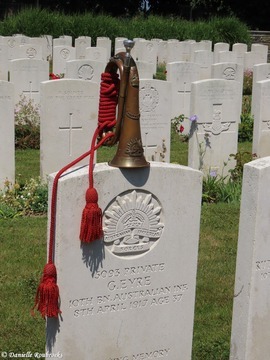
EYRE, George
| Service Number: | 5093 |
|---|---|
| Enlisted: | 18 January 1916 |
| Last Rank: | Private |
| Last Unit: | 10th Infantry Battalion |
| Born: | Buln Buln East, Victoria, Australia, June 1881 |
| Home Town: | Warragul, Baw Baw, Victoria |
| Schooling: | Buln Buln East State School, Victoria, Australia |
| Occupation: | Blacksmith |
| Died: | Killed in Action, France, 8 April 1917 |
| Cemetery: |
Moeuvres Communal Cemetery Extension V. B. 11., |
| Memorials: | Adelaide National War Memorial, Australian War Memorial Roll of Honour, Warragul Methodist Church Honour Roll |
World War 1 Service
| 18 Jan 1916: | Enlisted AIF WW1, Private, 5093, 10th Infantry Battalion | |
|---|---|---|
| 25 Mar 1916: | Involvement Private, 5093, 10th Infantry Battalion, --- :embarkation_roll: roll_number: '10' embarkation_place: Adelaide embarkation_ship: HMAT Shropshire embarkation_ship_number: A9 public_note: '' | |
| 25 Mar 1916: | Embarked Private, 5093, 10th Infantry Battalion, HMAT Shropshire, Adelaide | |
| 8 Apr 1917: | Involvement AIF WW1, Private, 5093, 10th Infantry Battalion, The Outpost Villages - German Withdrawal to Hindenburg Line, Killed in action |
Help us honour George Eyre's service by contributing information, stories, and images so that they can be preserved for future generations.
Add my storyBiography contributed by St Ignatius' College
George Eyre was born in June 1881. He was born in Buln Buln East, Victoria, Australia, but he lived in Albert Street, Warragul, Victoria, Australia. George worked as a blacksmith and was a member of the Church of England. His parents’ names were James and Sarah Eyre. George was not married, and he did not have children, but he had siblings: James and Sarah (presumably named after their parents). George was 5 feet and 6½ inches tall. George weighed 150 pounds when he enlisted in the war. He had blue eyes, brown hair and a fresh complexion, as well as a tattoo on his upper right arm.
George enlisted in the war on the 18th January 1916. At this time, he was 34 years and 7 months old. He was a Private in the 10th Battalion, 16th Reinforcement with the service number 5093. His records indicate that he did not do any training, however, the 10th Battalion unit diaries occasionally mention training. Although, if this training was not on his service records, it most likely did not require George to be transferred to a different place from where the 10th Battalion were fighting. Two months after he enlisted, on the 25th March 1916, George embarked from Adelaide on board the HMAT A9 Shropshire. During August 1916 he proceeded overseas to join his unit, the 10th Battalion. On the 25th August 1916 he joined the 10th Battalion on the Western Front in France from the reinforcements. Since there is nothing on his service records between the end of August 1916 and April 1917, George may have been doing some training in France or taking part in warfare on the Western Front.
In the week leading up to George’s death (on the 8th April 1917) the 10th Battalion had been preparing to move to a new position on the Western Front. On the 2nd April 1917 they were “loading transport” and “generally preparing to move” from Bresle, according to the unit diaries. By the 7th April, they had moved to the front line on the North of Louverval. This is the place where George died.
On the 8th April 1917, George was killed in action. The unit diary entry for that date states that the “line advanced about 1000 yards at 0300.” Four officers (lieutenants and captains) were wounded. There were also around forty other casualties that day. This event is presumably how George was killed. Considering that George had not done any military service beforehand and there is no evidence of him taking part in any significant training, being part of an advancing line is quite a brave thing to do.
When George was killed in action, he was buried in an isolated grave 30 yards west of 2nd Class Road, North Corner of Louverval Wood in France. However, his remains were exhumed and reinterred towards the end of 1920. George was reburied in the Moeuvres Communal Cemetery Extension (Plot V, Row B, Grave No. 11) in France. In his will, he left twenty-five pounds to each of his nieces and nephews (the children of his brother, James). His will also mentioned leaving some of his property to his sister, Sarah Powell Eyre.
George received two awards after the war finished: a Victory Medal in February 1922 and a British War Medal in April 1924. British War Medals were awarded to officers and men of British and Imperial forces who served in World War I. Similar to British War Medals, Victory Medals were awarded to everyone who served in the army during World War I. It was made to commemorate the victory of the Allied Forces over the Central Powers.












